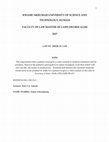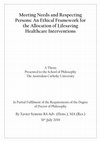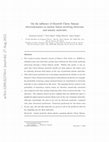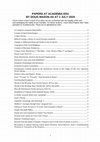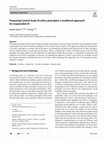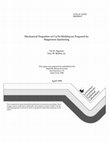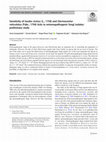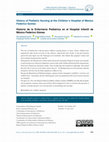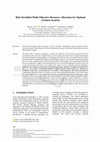This art icle was downloaded by: [ New York Universit y]
On: 27 May 2015, At : 15: 29
Publisher: Rout ledge
I nform a Lt d Regist ered in England and Wales Regist ered Num ber: 1072954 Regist ered office: Mort im er House,
37- 41 Mort im er St reet , London W1T 3JH, UK
The American Journal of Bioethics
Publicat ion det ails, including inst ruct ions f or aut hors and subscript ion inf ormat ion:
ht t p: / / www. t andf online. com/ loi/ uaj b20
Compassion for Each Individual's Own Sake
a
Art hur Caplan & Alison Bat eman-House
a
a
New York Universit y Langone Medical Cent er Division of Medical Et hics
Published online: 17 Oct 2014.
Click for updates
To cite this article: Art hur Caplan & Alison Bat eman-House (2014) Compassion f or Each Individual's Own Sake, The American
Journal of Bioet hics, 14: 11, 16-17, DOI: 10. 1080/ 15265161. 2014. 957622
To link to this article: ht t p: / / dx. doi. org/ 10. 1080/ 15265161. 2014. 957622
PLEASE SCROLL DOWN FOR ARTI CLE
Taylor & Francis m akes every effort t o ensure t he accuracy of all t he inform at ion ( t he “ Cont ent ” ) cont ained
in t he publicat ions on our plat form . However, Taylor & Francis, our agent s, and our licensors m ake no
represent at ions or warrant ies what soever as t o t he accuracy, com plet eness, or suit abilit y for any purpose of t he
Cont ent . Any opinions and views expressed in t his publicat ion are t he opinions and views of t he aut hors, and
are not t he views of or endorsed by Taylor & Francis. The accuracy of t he Cont ent should not be relied upon and
should be independent ly verified wit h prim ary sources of inform at ion. Taylor and Francis shall not be liable for
any losses, act ions, claim s, proceedings, dem ands, cost s, expenses, dam ages, and ot her liabilit ies what soever
or howsoever caused arising direct ly or indirect ly in connect ion wit h, in relat ion t o or arising out of t he use of
t he Cont ent .
This art icle m ay be used for research, t eaching, and privat e st udy purposes. Any subst ant ial or syst em at ic
reproduct ion, redist ribut ion, reselling, loan, sub- licensing, syst em at ic supply, or dist ribut ion in any
form t o anyone is expressly forbidden. Term s & Condit ions of access and use can be found at ht t p: / /
www.t andfonline.com / page/ t erm s- and- condit ions
�The American Journal of Bioethics, 14(11): 16–31, 2014
Copyright © Taylor & Francis Group, LLC
ISSN: 1526-5161 print / 1536-0075 online
DOI: 10.1080/15265161.2014.957622
Open Peer Commentaries
Compassion for Each Individual’s
Own Sake
Downloaded by [New York University] at 15:29 27 May 2015
Arthur Caplan, New York University Langone Medical Center Division of Medical Ethics
Alison Bateman-House, New York University Langone Medical Center Division
of Medical Ethics
Walker, Rogers, and Entwistle (2014) frame the issue of
access to unapproved medical interventions (via special
access programs such as early access, expanded access,
compassionate use, named patient programs, etc.) as
grounded in an ethical conflict between individuals and
populations. Specifically, they depict showing compassion
to individuals who have no treatments for their various
medical issues as hindering the clinical research and regulatory approval process by which treatments become available for everyone.
Walker and colleagues think they can resolve the
dilemma of individual interest competing against the public good. They would grant individuals access to unapproved medical interventions in the name of compassion
as long as data is derived from the experience that those
individuals have with the novel treatment. These clinical
data are seen as an adjunct to the standard testing of new
treatments. Thus, according to Walker and her co-authors,
compassionate use in individuals can aid the general population—in their terms, promote a corporate good—while
offering assistance to individuals in need.
We agree with the authors that there are sometimes
ways to allow individuals special access that do not compromise the ability to collect sufficient data to protect the
health of the general public and future potential users. But
we wish to underscore three points.
First, desperately ill patients who receive access to
unapproved treatments may not provide worthwhile clinical data, simply on account of their degree of illness or disability. The terminally ill and extremely sick can shed little
light on safety concerns. Demanding that data be collected
on these patients to satisfy the corporate or common good
is useful only to the extent that it is scientifically meaningful; otherwise, it is simply make-work that costs time,
money, and effort.
Second, granting individuals compassionate access can
still be at odds with the protection of the common good if
special access decreases the number of individuals willing
to serve in clinical trials. Compassionate use and other special access programs provide individuals with the desired
intervention, a much more appealing proposition than
potentially being assigned to the placebo arm of a clinical
trial. While data may be generated from giving individuals
with a disease or a terminal illness access, it is not the gold
standard data that would be produced by a randomized,
blinded clinical trial (Caplan 2007). The latter serves
the common good far more than the less powerful data
produced by studying a group of sick individuals, all of
whom are receiving a novel intervention.
The key ethical point we wish to make is that there
does not appear to be public demand for special access to
unapproved treatments to be justified by appeals to utility
or by furthering a public good. As we have seen in cases
like that of Josh Hardy (Caplan and Moch 2014), the public
is typically eager to grant individuals special access to
drugs, devices, operations, and the like solely on the
grounds of a duty to rescue those facing imminent, serious
peril. When people face dire outcomes, we are compelled,
morally and psychologically, to try to help them. We do
not feel a need to justify this for any reasons other than
compassion for their plight.
It is important to face squarely this human desire to
rescue. It is often a moral value that is omitted in debates
over compassionate use, including the discussion by
Walker and colleagues. Acknowledging our urge to rescue
allows us to confront other facts: for instance, that we are
commonly more compelled psychologically and emotionally to rescue some types of people (e.g., children,
“innocent victims,” the photogenic) than certain others (e.
g., members of stigmatized populations, the elderly). Furthermore, by acknowledging the powerful pull of rescue,
we are better positioned to understand situations such as
the case of Sarah Murnaghan, in which a dying child was
given a donor organ even though, on medical grounds,
Address correspondence to Arthur Caplan, New York University Langone Medical Center Division of Medical Ethics, 227 E. 30th Street,
New York, NY 10016, USA. E-mail: arthur.caplan@nyumc.org
16 ajob
�Access to Unapproved Medical Interventions
Downloaded by [New York University] at 15:29 27 May 2015
she was likely not the most appropriate recipient for the
scarce resource (deSante et al. 2014).
If compassionate use can lead to the creation of valuable data, then surely these data ought be collected. The
moral case for granting access is far simpler in such cases.
But when the very ill and the dying cannot provide much
in the way of useful data or when granting access undermines any reasonable chance of obtaining the “best” data
through blinded, randomized trials, then Walker and
colleagues’ solution collapses. And since a combination of
compassion, pity, and duty leads many to want to provide
access even when there are no data to be had or the data
that can be accrued will be less than optimal, we need to
acknowledge that compassion toward individuals sometimes simply trumps the common good (Richardson 2012).
When and how to manage that fact ought be the subject of
far more moral and policy debate. &
REFERENCES
Caplan, A. 2007. Is it sound public policy to let the terminally ill
access experimental medical innovations? American Journal of Bioethics 7(6): 1–3.
Caplan, A. and K. Moch. 2014. Rescue me: The challenge of
compassionate use in the social media era. Health Affairs Blog.
Available at: http://healthaffairs.org/blog/2014/08/27/rescueme-the-challenge-of-compassionate-use-in-the-social-media-era
deSante, J., A. Caplan, B. Hippen, G. Testa, and J. D. Lantos. 2014.
Was Sarah Murnaghan treated justly? Pediatrics 134(1): 1–8.
Richardson, H. S. 2012. Moral entanglements. New York, NY:
Oxford University Press.
Walker, M. J., W. A. Rogers, and V. Entwistle. 2014. Ethical justifications for access to unapproved medical interventions: An argument for (limited) patient obligations. American Journal of Bioethics
14(11): 3–15.
FDA Implementation of the Expanded
Access Program in the United States
Michelle Roth-Cline, U.S. Food and Drug Administration
Robert Nelson, U.S. Food and Drug Administration
The key question that must be addressed when making
investigational drugs available for treatment use is how to
fairly balance the interests of various stakeholders—
patients’ desire for access to investigational drugs prior to
marketing authorization, society’s interest in the efficient
development of new therapeutic options for life-threatening diseases or conditions, and the need to protect seriously ill patients from unacceptable risks. Walker and
colleagues (Walker, Rogers, and Entwistle 2014) provide a
perspective on the ethical justification for special access
programs (SAPs). Noting the tension between the desire of
individuals to access investigational drugs and society’s
need for data establishing the safety and efficacy of those
drugs, Walker and colleagues propose that patients who
receive an investigational drug under an SAP have an obligation to agree to the collection of data to generate knowledge. We would like to provide an additional perspective
on how the current implementation of the expanded access
program (EAP) for investigational drugs and biological
products by the U.S. Food and Drug Administration
(FDA) addresses several concerns about SAPs that were
raised by the authors.1
Although expanded access was allowed informally
earlier, there was no recognition of treatment use in FDA’s
regulations until 1987. In part to ensure that pivotal trials
were not delayed by allowing expanded access, the agency
updated and expanded its regulations on EAPs in 2009
(FDA 2009). Investigational drugs and biological products
that may be sought by patients under the EAP in the
United States are FDA-regulated products that have been
the subject of a previous investigational new drug (IND)
application (FDA 2009, 40901). The administration of an
IND-regulated investigational drug or biological product
to a human being is considered a “clinical investigation” (i.
e., FDA-regulated research), even if the product is only
administered to a single subject (FDA 1987). As such, all
IND regulations pertaining to the conduct of FDA-regulated research apply, including initial and continuing FDA
review, ethics oversight and informed consent, and data
collection and reporting requirements. Contrary to the
statement by Walker and colleagues that SAPs “are not
clearly either research or routine clinical practice,” administering an investigational drug under the EAP in the
United States is defined clearly as an FDA-regulated
This article is not subject to U. S. Copyright Law.
Address correspondence to Robert M. Nelson, U.S. Food and Drug Administration, Office of Pediatric Therapeutics, 10903 New Hampshire Ave., WO32, Room 5126, Silver Spring, MD 20993, USA. E-mail: Robert.nelson@fda.hhs.gov
1. The views represented in this commentary are solely those of the authors and do not necessarily represent the position of the Food and
Drug Administration or the Department of Health and Human Services.
November, Volume 14, Number 11, 2014
ajob 17
�
 Arthur Caplan
Arthur Caplan Alison Bateman-House
Alison Bateman-House





